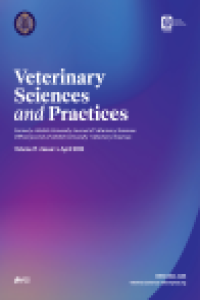Histologic and Histometric Examination of Spleen in Geese (Anser anser)
The aim of this study was to examine the histometrical and histological structures of goose (Anser anser) spleen. Six healthy female geese were used as material. Tissue samples taken from the spleen were processed routinely, and were then stained with H&E, Crossman’s Triple stain and Toluidine blue stain. The spleen surrounded by capsules composed of connective tissue and parts of the capsules were observed increasingly thinning into the spleen as trabeculae. The red pulp area was distinguishable from the white pulp inside the organ; further, the lymph follicles appeared clearly within the white pulp. Histometric measurements revealed that the thickness of the capsules surrounding the organ ranged from 18 to 28 μm. The average thickness of the capsules was measured as 22 μm. The average number of lymph follicles was found to be 2.4 in 1.07 mm2. The average width and length of the lymph follicles were measured as 113 μm and 144 μm, respectively. The average diameter of the mast cells was found to be 6 μm. The average number of mast cells was found to be 1.4 in 1.07 mm2. Although the histological structures of the geese spleens seemed very similar to those of other animals in several respects, but some specific properties of geese spleens being more similar to that of mammalians were also observed.
Anahtar Kelimeler:
Dalak, Histometri, Kaz, Lenf folikülü, Mastosit
-
The aim of this study was to examine the histometrical and histological structures of goose (Anser anser) spleen. Six healthy female geese were used as material. Tissue samples taken from the spleen were processed routinely, and were then stained with H&E, Crossman’s Triple stain and Toluidine blue stain. The spleen surrounded by capsules composed of connective tissue and parts of the capsules were observed increasingly thinning into the spleen as trabeculae. The red pulp area was distinguishable from the white pulp inside the organ; further, the lymph follicles appeared clearly within the white pulp. Histometric measurements revealed that the thickness of the capsules surrounding the organ ranged from 18 to 28 µm. The average thickness of the capsules was measured as 22 µm. The average number of lymph follicles was found to be 2.4 in 1.07 mm2. The average width and length of the lymph follicles were measured as 113 µm and 144 µm, respectively. The average diameter of the mast cells was found to be 6 µm. The average number of mast cells was found to be 1.4 in 1.07 mm2. Although the histological structures of the geese spleens seemed very similar to those of other animals in several respects, but some specific properties of geese spleens being more similar to that of mammalians were also observed
Keywords:
Goose, Histometry, Lymph follicle, Mast cell, Spleen,
___
- Alabay B., 2008. Lymphoid system. In “Veteriner Özel Histoloji”, Ed., A Ozer, 49-66, Nobel Press, Ankara.
- Asti RN., Tanyolac A., Kurtdede N., Ozen A., 1997. Distribution of T and B lymphocytes in Angora Goat tissues. Turkish Journal of Veterinary & Animal Sciences, 21, 99-105.
- Balcan E., Arslan O., Gumus A., Sahin M., 2009. The effect of tunicamycin on embryonic and newborn murine spleen tissues. Journal of the Faculty of Veterinary Medicine, Kafkas University, 15, 651-660.
- Biljana M., Ana R., Ruzica A., Ljiljana D., Mileva M., 2008. Changes in lymphatic organs of layer chickens following vaccination against marek’s disease: histological and stereological analysis. Acta Veterinaria (Beograd), 58, 3-16.
- Bradley OC., 1915. The structure of the fowl. 79-88. A.& C. Black, LTD. London.
- Caughey G.H., 2011. Mast cell proteases as protective Advances in Experimental Medicine and Biology, 716, 212-234. mediators.
- Causey Whittow G., 2000. Strukie’s Avian Physiology, 5th ed., 659-661. Academic Press. London.
- Fitzgerald TC., 1969. The Coturnix Quail. Anatomy and Histology. 237-238. The Iowa State University Press, Ames, Iowa.
- Galli SJ., Dvorak AM., Dvorak HF., 1984. Basophils and mast cells: morphologic insights into their biology, secretory patterns, and function. Progress in Allergy, 34, 1-141.
- Hodges RD., 1974. The Histology of the Fowl. 221- 225. Academic Press. London.
- Jamur MC., Grodzki ACG., Berenstein EH., Hamawy MM., Siraganian RP., Oliver C., 2005. Identification undifferentiated mast cells in mouse bone morrow. Blood, 105, 4282-4289. of the 121. osprey (Pandion
- Kroese FGM., Wubbena KC., Kuijpers KC., Nieuwenhuis P., 1987. The ontogeny of germinal centre forming capacity of neonatal rat spleen. Immunology, 60, 597-602.
- Liman N., Bayram GK., 2011. Structure of the quail (coturnix coturnix japonica) spleen during pre- and post-hatching periods. Revue de Medecine Veterinaire, 162, 25-33.
- Luna LG., 1968. Manual of Histologic Staining Methods of Armed Forces Institute of Pathology, 3rd ed., 32-46. Mc Graw-Hill Book Comp., London.
- Payne LN., 1971. The Lymphoid System. In “Physiology and Biochemistry of the Domestic Fowl”, Ed., BellDJJ., Freeman BM., 985-1037. Academic Press. London.
- Ross MH., Pawlina W., 2011. Histology: A Text and Atlas, 6th ed., 471-474. Lippincott Williams and Wilkins. Baltimore, Philadelphia.
- Starck JM., Riclefs RE., 1998. Avian growth and development: Evolution within the altricial- precocial. 205-208. Oxford University Press. New York.
- Straus AH., Nader HB., Dietrich CP., 1982. Absence of heparin or heparin-like compounds in mast- cell-free tissues and animals. Biochimica Biophysica Acta, 717, 478-485.
- Thangapandiyan M., Balachandran C., 2010. evaluation Cytological lymphadenopathies- a review of 109 cases. Veterinarski Arhiv, 80, 499-508. of canine
- Thorbecke GJ., Gordon HA., Wostman B., Wagner M., Reyniers JA., 1957. Lymphoid tissue and serum gamma globulin in young germfree chickens. The Journal of İnfectious Diseases, 101, 237-251.
- Tischendorf F., 1985. On the evolution of the spleen. Experientia, 41, 145-152.
- Uslu S., Yoruk M., 2013. Morphological and histometric studies on mast cell distribution and heterogeneity, present in the lower respiratory tract and in the lung of local duck (Anas platyrhnchase) and goose (Anser anser). Journal of the Faculty of Veterinary Medicine, Kafkas University, 19, 475-482.
- Başlangıç: 2022
- Yayıncı: Atatürk Üniversitesi
